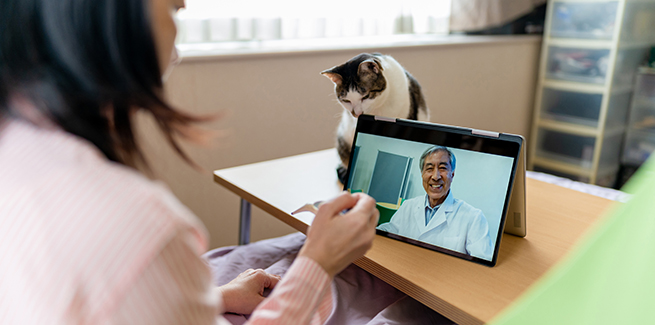Telemedicine update

During the early days of the pandemic, when confusion was at its peak and many thought they might have to weather long-term practice closures, the US Food and Drug Administration (FDA) issued CVM GFI #269. This temporary guidance was designed to ease the transition from in-person veterinary visits to telemedicine, which, in most states, required an already-established veterinarian-client-patient relationship (VCPR).
But did that mean veterinarians had carte blanche to perform telemedicine with whomever they pleased? Not quite. VCPR requirements are subject to both federal and state regulations, depending on the situation.
According to Gail Golab, PhD, DVM, MANZCVS, DACAW, chief veterinary officer of the AVMA, the federal definition of the VCPR applies to both extralabel drug use and issuing Veterinary Feed Directives. “Because the number of drugs available to treat specific conditions in specific species of animals is limited, the amount of extralabel drug use that takes place in companion-animal medicine is substantial,” she said. “To help veterinarians deliver veterinary care during the pandemic, the FDA decided it would temporarily apply discretion to enforcing this requirement of the federal VCPR.”
Regardless of whether these federal VCPR requirements apply to a visit, individual state VCPR requirements remain in place. According to legal expert Mark Cushing, JD, although individual state regulations are independent of the FDA, the FDA special guidance was an important factor in persuading more states to relax their requirement for a VCPR to practice telemedicine during the pandemic.
Cushing is a founding member of the Veterinary Virtual Care Association (VVCA) and chair of the VVCA Advisory Council. A global, nonprofit association with a mission that includes developing best practices for delivering virtual care for animals and defining quality standards and protocols for practicing virtual care, the VVCA also advocates for policies in support of quality virtual care.
In matters of telemedicine, Cushing said the final decisionmakers on veterinary telemedicine are the states. And policies vary widely. You can see just how widely by checking out the VVCA’s interactive map, which lists the current VCPR laws in every state, as well as which states adopted temporary changes to their VCPR telemedicine requirements to accommodate the need for social distancing during the pandemic.
In most cases, the VCPR has to be established through an in-person, hands-on visit. Most states don’t allow you to establish a VCPR through telemedicine alone. But once that VCPR is established, the options open up. Cushing said that pre-COVID, every single state allowed veterinarians to practice telemedicine as long as they had a VCPR. “If I’ve got a VCPR with you, I can use telemedicine with you and your pet all day long.”
Cushing says the prefix “tele” is misleading in one sense, as it doesn’t necessarily mean via telephone, or even via televised means such as a video call. It means any communication other than in person.
If a VCPR is in place, veterinarians can communicate with clients any way they both agree to, Cushing said. “They can communicate by carrier pigeon.”
The only thing at issue is how you establish that VCPR, Cushing added: “The traditional VCPR rule says you can’t start a relationship unless you had an in-clinic, hands-on examination of the pet.” Many states waived that rule during COVID to temporarily allow a remote VCPR to be established using telemedicine. But now that COVID’s easing, the paths are beginning to diverge. Some states are going back to the old policy while others have decided to keep the new changes.
“Now that effective and safe vaccines against SARS-CoV-2 are available, risks associated with human-to-human contact have been substantively reduced,” said Golab. “Many practices are resuming normal operations, including welcoming clients and patients back into their examination rooms, and the need to apply regulatory discretion around the VCPR has been reduced. As a result, some states are no longer applying that regulatory discretion.”
On the flip side of the coin, Cushing said Michigan and New Jersey officially adopted a policy that allows veterinarians to establish a remote VCPR. Oklahoma just passed a similar bill that’s just waiting on the governor’s signature. Whether a veterinarian chooses to take advantage of establishing an in-person VCPR is a judgment call, said Cushing. “If the veterinarian thinks she’s got enough information, she can get started in a relationship with you and your pet [via electronic means],” Cushing said.
Golab notes the conflicting requirements on the state and federal level can be a source of confusion. “For example, if a state allows a VCPR to be established electronically and a veterinarian does so, but treatment for the animal’s condition requires the extralabel use of an animal or human drug (including over-the-counter human drugs), under federal law, treatment will not legally be able to be initiated without conducting an in-person examination of the patient,” she told NEWStat. “This may frustrate the client and can result in additional time and financial costs—including a potential delay in treatment.”
While Cushing and the VVCA have taken a stance in favor of less-restrictive regulations, the AVMA has a clear stance of its own: “Veterinary telemedicine holds great promise for improving continuity of care and strengthening the relationship between veterinarians and their clients,” Golab said. “However, veterinary telemedicine appears to be most effective and safest—for patients, clients, and veterinarians/veterinary practices—when utilized to maintain a VCPR that has already been established via an in-person consultation.”
No matter how you feel about telemedicine or whether states should allow for a remote VCPR using telemedicine, one thing’s clear: the conversations will continue.
Photo credit: © SetsukoN/ iStock / Getty Images Plus via Getty Images



